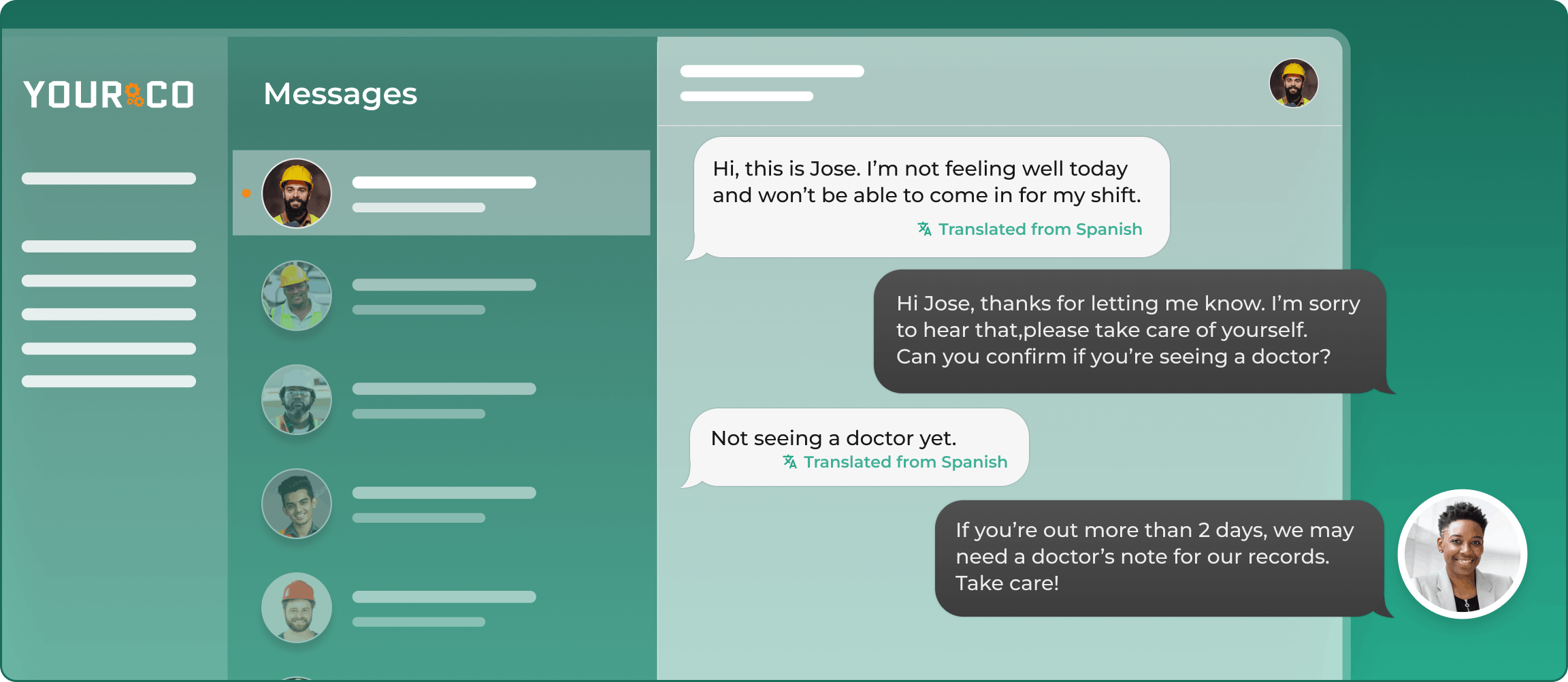The AI Prompts Guide for HR (with Templates!)


HR teams manage a constant flow of communication. From welcoming new hires to sending training reminders, giving feedback, and sharing policy updates, the writing never stops. Creating each message from scratch takes time and often distracts from the bigger priorities.
AI prompts change that. With a few clear instructions, you can generate a usable draft in seconds, keep the tone consistent, and deliver information to employees quickly.
This guide explains how to write effective prompts, highlights best practices, and includes ready-to-use templates for recruiting, onboarding, performance, and more.
AI Prompt Templates for Key HR Functions
→ Download the AI HR Templates Pack for free — Get all the templates in one document so you can copy, paste, and adapt them instantly.
AI prompts shine when they give you a quick, consistent starting point. Drop one into your favorite generative tool, tweak the details, and you've avoided starting from scratch. Below are ready-to-use templates, plus tips on tailoring them for office and non-desk teams alike.
1. Recruitment and Job Descriptions
Strong hires start with clear, inclusive language. A solid prompt can draft the first cut of the posting, help you prep interviews, and keep every candidate in the loop.
These templates provide comprehensive coverage for your hiring process:
- Write a job description for a {job_title} in {industry}, highlighting {skills_required}. Keep it welcoming and inclusive.
- Generate five behavioral interview questions for a {job_title} role that assess {specific_competency}.
- Draft a personalized outreach message for a candidate with experience in {field} for our {job_title} opening.
- Write a polite rejection SMS/email for applicants who didn't advance for {job_title}. Offer one line of constructive feedback.
After the AI produces a draft, swap in concrete examples from your workplace and double-check the wording for bias. If you're texting candidates, compress outreach or rejection notes to 160 characters so they fit in a single message.
2. Onboarding and Training
Few moments set the tone like day one. Prompts help you spin up welcome messages, training outlines, or FAQs in minutes, keeping every new hire on the same path.
Use these templates to streamline your onboarding workflow:
- Create a welcome SMS for a new {job_title}, listing day-one priorities and key contacts.
- Write a training outline for {topic} with learning outcomes and three short activities for a {duration} session.
- Generate an FAQ about {company_policy} in plain language.
- Create a 90-day onboarding plan for a {job_title}, including milestones and mandatory courses.
- Draft a short text message introducing {name} as our new {role}.
For field crews who don't check email often, convert welcome notes into short texts or printed cards. The FAQ prompt works perfectly for converting dense policy PDFs into quick-reference sheets you can post in break rooms.
3. Performance and Feedback
Consistent language keeps reviews fair and actionable. Let a prompt build the skeleton, then layer in your examples and data.
These performance-focused templates ensure balanced, constructive communication:
- Write performance feedback for an employee who excels at {strength} but needs improvement in {area}. Include two specific examples and one actionable tip.
- Draft a recognition message for an employee who wrapped up {project_name}. Highlight their biggest win in one sentence.
- Create a quarterly review template that blends metrics and narrative feedback.
- Generate a 90-day improvement plan for an employee struggling with {challenge}, with weekly checkpoints.
- Write a brief text congratulating {employee_name} on {achievement} to share with the team.
Before hitting send, verify the tone matches your culture and remove any phrases that could be misread. Text-size praise works wonders for non-desk staff who rarely open long emails.
4. Employee Engagement and Culture
Regular, upbeat messages build community, especially when teams rarely gather in the same room. Foster stronger connections with these engagement-focused prompts:
- Suggest five engagement activities for a {industry} company with {team_size} employees, including options for remote or field staff.
- Write a 150-word newsletter update about {initiative_name}, covering wins and next steps.
- Create a poll about {topic} with four multiple-choice questions to gauge sentiment.
- Draft an announcement for a company-wide {event_type}. Make the logistics crystal clear.
- Generate three motivational messages (under 160 characters) tied to our value of {value}.
When you deliver these via text, stagger send times so employees on night shifts don't get pinged during rest hours. Quick polls by text often earn higher response rates than intranet surveys.
5. Policy and Compliance
Policies only work if everyone understands them. Prompts help translate legal jargon into everyday language. Transform complex policies into accessible communication with these templates:
- Summarize our {policy_topic} policy in plain English — three short paragraphs max.
- Write a 160-character compliance reminder about {policy_area}.
- Create a step-by-step guide explaining how to follow the updated {procedure_name}.
- Draft an FAQ covering common questions about our {benefit_type}.
Consider having legal or senior HR colleagues review drafts. Machine-generated text can miss nuance, and a quick human review keeps you on the right side of the rules. Once cleared, you can paste the text version directly into your broadcast tool and reach every worker — no app store download needed.
Why HR Teams Should Use AI Prompts
Well-crafted AI prompts reduce time-consuming tasks and keep every HR message on track. When you can create a polished performance-review draft or an inclusive job ad in seconds, you free yourself to focus on hiring strategy, coaching, and culture rather than formatting documents.
Consider the time you spend writing feedback. A single review packet can take half a day. With a prompt like "Write balanced feedback for a warehouse picker who excels at accuracy but needs to improve speed," you get a usable first draft almost instantly. A quick edit and you're done.
The gains go beyond speed. Prompts enable you to standardize language so every candidate or employee hears the same, bias-free message. You can respond faster to questions because your draft is ready before you even open a blank page. Most importantly, you create strategic time, meaning that hours once lost to rewriting policies come back for planning and coaching.
Teams can generate shift announcements and FAQs quickly, then deliver them through their preferred communication channels. Supervisors working with a library of ready prompts often see daily communication time drop from ten minutes per employee to under two.
Best Practices for Writing HR Prompts
A clear, well-scoped prompt is the single biggest factor that decides whether AI gives you a useful draft or a disappointing wall of text.
Drafting the same types of messages repeatedly (welcome texts, policy reminders, performance feedback) can feel endless. The solution lies in giving AI enough context up front, which saves you from endless back-and-forth edits later.
- Start by spelling out the role, industry, and situation: "You are an HR specialist at a food-processing plant, drafting training reminders." This extra detail takes seconds to add and saves minutes of rewriting.
- Build in placeholders so you can reuse prompts without starting from scratch: {job_title}, {employee_name}, {policy_topic}. Think of these as your find-and-replace shortcuts. They let you tailor outputs quickly while keeping the structure that works.
- Tell AI exactly how you want the answer formatted: If you need a bullet list, say so. If the message will go out by text, remind the model to "keep it under 160 characters" and prioritize clarity — every word counts when you're targeting that high engagement rate.
- The same precision applies to longer pieces: "Write as a policy draft with numbered sections" produces cleaner copy than a vague request.
- Tone makes all the difference: Adding "friendly but professional" or "inclusive, plain-language style" helps AI mirror your brand voice instead of defaulting to stiff, robotic prose.
- Review outputs for consistency, accuracy, and potential bias: AI can still create outdated policies or miss important details, and you remain responsible for what employees receive.
Here's what that looks like in practice: "You are an HR manager at a logistics firm. Draft a warm, conversational SMS (under 160 characters) announcing a change to the health policy."
Plan on tweaking your prompts. A quick change, such as adjusting a verb or adding a constraint, often turns an average response into exactly what you need.
Make AI Prompts Part of Your HR Process
Pick one process and run a small pilot to see real impact without overwhelming your team. Job postings, onboarding messages, or policy reminders work well because they have clear templates you're already updating manually.
Start by training a few HR colleagues on basic prompt writing. Show them how to add context ("warehouse supervisor," "union environment"), use placeholders, and ask the AI for specific formats. Short practice sessions help everyone see how quickly a solid first draft appears.
Set up a two-step review before anything goes live. First, an HR peer checks tone and accuracy. Then a legal or compliance lead ensures the text matches company policy and avoids bias. This catches AI errors and keeps you in control of sensitive details.
Measure success with simple metrics:
- Compare drafting time versus editing time
- Track consistency by noting manager feedback requests
- Monitor engagement rates
Build a prompt library over time. Each time you tweak a prompt and get better results, save it to a shared folder tagged by use case.
Draft messages with prompts, then send them through a platform like Yourco that supports scheduling and translations. That way, frontline crews get clear, timely updates even if they never check email.
Automate HR Communication the Smart Way with Yourco
AI prompts cut hours from your writing workload, but the real win happens when those messages reach every employee's phone. Yourco's messaging platform takes your AI-generated draft, translates it automatically, schedules delivery around shift times, and sends it straight to phones.
You control when policy reminders or safety alerts go out, and Yourco handles the timing so no one gets interrupted during off-hours. Built-in translation in over 135 languages and dialects covers multilingual crews, while two-way texting lets workers reply with questions or confirm shifts instantly. Managers track engagement stats from one dashboard, making it simple to spot gaps and follow up.
When AI and Yourco work together, you go from "message drafted" to "message read" without much hassle. Try Yourco free today or schedule a demo and see the difference the right workplace communication solution can make in your company.
FAQs
Can AI prompts replace HR professionals?
AI handles the first draft, but it can't manage nuance, empathy, or legal judgment. It works like a tireless assistant that produces quick copy, while you decide what stays, what changes, and when a personal conversation is needed. Human review also prevents bias, which machines still struggle with.
How can I make sure AI outputs are legally compliant?
Treat every AI draft like it needs review. Give clear prompts that include policy names, desired tone, and word limits. Then run a quick checklist: Is the language inclusive? Does it match current law? Does it expose private data? For sensitive topics, bring in your legal or compliance team.
Are these prompts useful for non-desk employees?
Yes, especially when structured for information that will be distributed via text messaging. Messages reach almost everyone, including workers without email, and achieve exceptional engagement rates. Keep messages under 160 characters and request plain language. This turns policy updates, shift reminders, or training snippets into quick texts that frontline teams read.
How do I integrate AI prompt outputs into daily HR communication?
Start small with one workflow, like weekly shift reminders. Draft your prompt, generate the message, review it, and schedule it through your messaging system. Build a simple routine: generate, review, schedule, measure engagement, refine the prompt. Combining AI's speed with reliable delivery helps you move fast without losing accuracy, creating a feedback loop that keeps both office and field teams informed.




